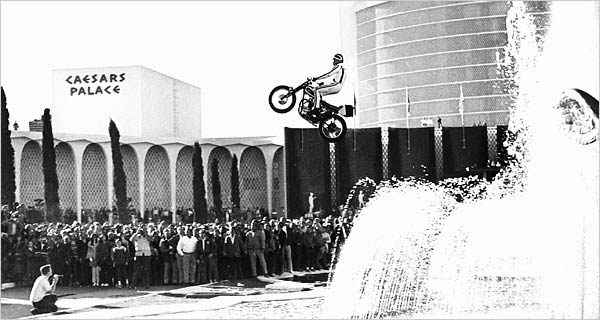Charles Fishman, author of The Big Thirst, nominates Las Vegas as the most water savvy area of the United States. It seems counterintuitive that a piece of desert crammed with swimming pools and gargantuan fountains could be considered water smart, but the city consistently makes it work despite meagre natural resources. An excerpt from his book at Marketplace:
“There is no two-mile stretch of ground anywhere in the United States that has such a density of water features, water attractions, and sheer water exuberance. Las Vegas, which can invest something as routine as breakfast with outlandish extravagance, has taken our most unassuming substance and unleashed it as the embodiment of glamour, mystery, power, and allure. In the way that only Las Vegas can, it has created a whole new category–ostentatious water.
The Las Vegas Strip is a demonstration of water imagination, of water mastery, and also of absolute water confidence.
It’s all the more remarkable because Las Vegas is the driest city in the United States. Of the 280 cities in the United States with at least 100,000 people, Las Vegas is No. 280 in precipitation and No. 280 in number of days each year that it rains. Las Vegas gets 4.49 inches of precipitation a year. And it rains or snows, on average, just nineteen days a year.
A metropolis with 2 million residents and 36 million visitors a year, Las Vegas gets ninety percent of its water from a single source, Lake Mead, the spectacular, man-made reservoir created on the Colorado River by Hoover Dam. When Lake Mead is full, it holds a sixty-year supply of water for Las Vegas.
But Las Vegas is legally allowed to take only a tiny sliver of Lake Mead water — 300,000 acre-feet a year, 98 billion gallons. All the water Las Vegas is allowed lowers the lake between two and three feet. Las Vegas’s allocation is about 4 percent of what everybody else gets to take from Lake Mead — 96 percent of the water people use from Lake Mead goes to either California or Arizona. And Las Vegas’s allocation is fixed in law, just as the allocations of California and Arizona are fixed — so the amount of water Las Vegas has access to hasn’t changed even as Las Vegas’s population has doubled, and doubled again, even as the city has added 100,000 new hotel rooms, along with fountains and waterfalls, swimming pools and shark tanks.”
••••••••••
Evel Knievel’s failed attempt at jumping the fountains at Caesars Palace, 1967:
Tags: Charles Fishman, Evel Knievel

